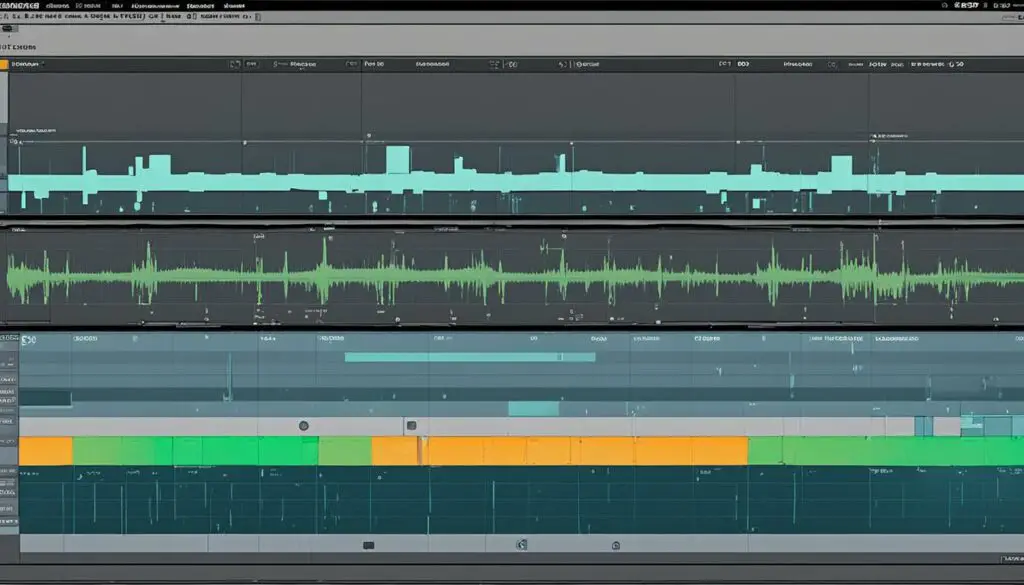What is the role of panning in Dual Vocal Mashups?
Panning is key in making Dual Vocal Mashups sound better. It helps create depth and a more immersive experience. By placing the two vocal tracks in the right spots, producers can make the mix clear and cohesive.
In Dual Vocal Mashups, panning adds space and separation between the voices. By placing one track to the left and the other to the right, it’s easier to tell the voices apart. This makes the performance more engaging and dynamic.
Panning can also highlight certain vocal parts. By putting background vocals or effects off-center, the main vocal stays in the middle. This creates a rich, immersive sound that grabs the listener.
Also, panning helps balance the mix in Dual Vocal Mashups. By placing the vocals well with the other instruments, they stand out clearly. This careful panning is key for a polished, professional sound in these mashups.
Understanding Panning in Music Production
Panning is key in music production. It helps place sounds in the stereo field. By adjusting the sound signal, producers can make the mix sound wider and clearer. This makes each sound clear and distinct.
Panning Instruments for Spatial Separation
Panning helps separate instruments in a mix. Drum elements like kick drums, snares, and hi-hats are usually panned in the center. This keeps the beat strong and clear.
Guitars, keyboards, synths, and backing vocals are panned off-center. This makes the mix wider and deeper. Creative panning, like using LFO automation, adds movement to sounds. Panning vocals wide makes them sound fuller.
Mono vs. Stereo Tracks: When to Use Each
Choosing between mono and stereo tracks depends on the sound and effect wanted. Mono is good for clear sounds like vocals and bass. It avoids phasing issues.
Stereo is best for sounds that need a wide soundstage, like drum overheads and pads. Using panning wisely helps create a rich, immersive sound. This makes the music feel more real.

Dual Vocal Mashup Techniques
Making great dual vocal mashups is all about mixing and matching the two voices well. Producers use cool tricks like pitch-shifting, harmonizing, and beat-boxing to make the voices sound good together. It’s important that the two voices support each other but still stand out in the mix.
Layering and Blending Vocals
Layering and blending the vocals is a big part of making mashups work. Producers might use pitch-shifting for harmonies or beat-boxing for rhythm. The aim is to make the two voices sound like one, creating a fresh and exciting sound.
- Make sure the tempos and keys of the vocals match for a smooth blend.
- Try pitch-shifting and harmonizing to add depth to the vocals.
- Add beat-boxing for more rhythm and energy.
- Adjust the volume and where the vocals sit in the mix for a full sound.
- Use a cappella parts to highlight the singers and make the mashup more powerful.
By getting good at these techniques, producers can make mashups that are both catchy and show off their skills.

Panning Strategies for Dual Vocal Mashups
Creating captivating dual vocal mashups means using strategic panning. This makes the mix sound wider and clearer. It lets each vocal stand out in its own space.
One good way is to put the main lead vocal right in the middle. Then, place the secondary vocal a bit off-center or on the other side. This makes the two vocals clear and separate. By doing this, the dual vocal mashup sounds deeper and more interesting.
Another method is to pan the vocals really far apart, like hard left and hard right. This makes the sound feel wider and pulls the listener into the music. But, it’s important to keep the vocals working well together.
Some producers like to move the vocals around in the mix over time. This adds more depth and keeps the listener engaged. It stops the mix from sounding the same all the time.
By trying out different panning strategies, producers can make dual vocal mashups that grab the listener. They highlight the special interaction between the two voices. This creates a rich, engaging experience for the listener.
| Panning Technique | Description | Potential Benefits |
|---|---|---|
| Center-Offset Panning | Main lead vocal in the center, secondary vocal slightly off-center or to the opposing side. | Enhances perceived width and clarity, allows each vocal to occupy its own sonic space. |
| Extreme Panning | Lead vocal hard left, supporting vocal hard right. | Creates a wider, more enveloping soundstage, immerses the listener in the dual vocal mashup. |
| Panning Automation | Dynamic panning of vocals throughout the song. | Adds depth and movement, prevents the mix from feeling static or one-dimensional. |
The Importance of Reverb and Ambience
Reverb and ambience are key in Dual Vocal Mashups. They add depth and make the mix feel more real. By using reverb on vocals, producers can make it seem like the vocals are in different places. Finding the right mix of wet and dry signals is important to keep the vocals clear.
Creating Depth and Space with Reverb
Reverb makes vocals sound bigger and more distant. The right amount depends on the music style and the feel you want. But, too much can make vocals hard to hear. It’s best to add reverb on a separate channel for mixing vocals.
There are different types of reverb like Plate, Hall, Room, and Chamber. Each one changes the sound in its own way. Using too many can confuse the listener, so finding the right mix is key.
To make great vocal sounds, consider five things: reverb type, decay time, pre-delay, wet/dry balance, and EQ. By trying different settings and effects, you can make the vocals in a Dual Vocal Mashup sound amazing.
In songs like Billie Eilish’s “Bury A Friend,” the reverb adds a spooky feel. In Adele’s “Hello,” it creates a close and emotional vibe. Reverb can also make vocals move and add texture to the music.
Using reverb and ambience well is key to a great Dual Vocal Mashup. It makes the music feel more real and immersive. By getting good at these techniques, producers can make their vocal blends sound incredible.
Balancing and Mixing Dual Vocal Mashups
Creating a smooth mix of dual vocal mashups needs careful attention to the mix’s balance. It’s important to adjust the volume levels of both vocals so they work well together. Using EQ and dynamics processing helps blend the vocals smoothly while keeping their unique qualities. The goal is to make a mix that draws the listener in.
Getting the volume levels right is key in balancing dual vocal mashups. Mix engineers suggest making the lead vocal very quiet, almost like a normal conversation level. This lets the secondary vocal fit in well, making the mix balanced and cohesive.
Using EQ and dynamics processing is also vital. A 6dB per octave high-pass filter can help clear up the low end in the doubles and harmonies, making room for the lead. Heavy de-essing reduces harsh sounds in the harmonies, improving the overall blend.
Tuning the vocals can also make a big difference in modern mixes. Compressing the harmonies helps control their volume and mix them smoothly with the lead. Adding stereo sample delay to the harmonies makes the sound wider and more impressive. Panning the doubles and harmonies in the 90-degree field changes how they sound in the mix.
To balance the mashup, producers can try M/S EQ on a bus to boost the low mids and highs on the side. Saturating the vocals with a plugin like Arturia’s Tube Culture can make them sound fuller and control their dynamics better. A plugin like Soothe 2 with side-chain lead can also help manage the harmonies’ frequencies compared to the lead.
By tweaking the volume levels, using EQ and dynamics processing, and applying special mixing techniques, producers can make a dual vocal mashup that grabs the listener’s attention.
| Mixing Technique | Recommended Settings |
|---|---|
| Gate | 6-10dB range |
| High-pass Filter | 6dB per octave slope |
| De-essing | Heavy reduction of sibilance |
| Compression | Significant compression on harmonies |
| Stereo Delay | Use stereo sample delay on harmonies |
| Panning | Pan doubles and harmonies within 90-degree stereo field |
| M/S EQ | Boost low mids and highs on side image |
| Saturation | Use Arturia Tube Culture for collective vocal saturation |
| Resonance Management | Use Soothe 2 with side-chain lead |
Conclusion
Making great Dual Vocal Mashups is all about using panning, spatial separation, and reverb well. By getting good at these skills, music producers can make mixes that grab the audience’s attention. They can make the music feel rich and full.
Panning is key to making the dual vocals sound clear and separate. It helps them blend together smoothly in the mix. Knowing how to use mono and stereo tracks, and panning them right, is crucial for a professional sound.
Using reverb and ambience wisely can also make a Dual Vocal Mashup stand out. It adds depth and space, taking the listener on a journey. With the right balance and these elements, producers can take their mashups to the next level. They’ll leave a mark in the music world.







